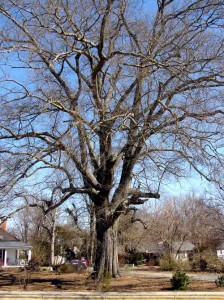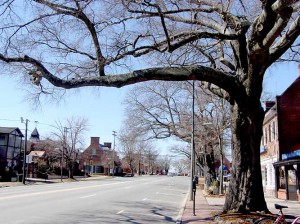Trees have rights

Grand old oak across from Town Hall most likely witnessed the naming of Carrboro. Photo by Ken Moore.
By Ken Moore
The rights of trees were important to geologian Thomas Berry (1915-2009), who described his thinking about human activity on Earth in his book The Great Work. Recently, the Center for Ecozoic Studies (ecozoicstudies.org) convened a gathering in Chapel Hill of over 100 people to learn more about Berry’s works and philosophy. What a comfort to be in the midst of kindred beings so in touch with the nature of the Earth we all share.
Berry’s view of our current reality is stark. “The most basic and most disturbing commitment of the original European settlers was to conquer this continent and reduce it to human use.… Just now we seem to be expecting some wonderworld to be attained through an ever-greater dedication to our science, technologies, and commercial projects. In the process, however, we are causing immense ruin to the world around us.â€
The continuation of human “business-as-usual†activities will rapidly lead, in Berry’s estimation, to a cataclysmic change on Earth not experienced since the extinction of the dinosaurs 65 million years ago. He sees us now approaching the end of the intervening Cenozoic Era and destroying in only a couple hundred years much of the magnificent biodiversity that evolved during that 65-million-year period.
Being positive, he also sees the possibility of a new period, “an Ecozoic Era, a period when humans become a mutually beneficial presence on the Earth. That future can only exist when we understand the universe is composed of subjects to be communed with, not as objects to be exploited.â€
Acknowledging that, “We cannot own the Earth or any part of the Earth in any absolute manner,†Berry places our human rights, so self-centeredly described in our nation’s Bill of Rights, in the context of all beings (“subjectsâ€) in the universe having rights. “Trees have tree rights, insects have insect rights, rivers have river rights, mountains have mountain rights.â€
For me, the giant trees in our community symbolize at once the wonders of our environment, the stark realities of human destruction and the potential to reverse our destructive habits that are all so engagingly described in The Great Work.
That giant willow oak shading the yard directly across from Carrboro’s Town Hall makes me pause in the knowledge that it probably stood there prior to the town being officially named Carrboro in 1913. I’m happy it has been allowed the right to remain.
I marvel even more at the curbside survival of those big oaks on West Franklin Street, dreading the time when their right to live and thrive may be taken by streetscape beautification working its way westward.
Whether walking in town or on forest trails, pause and ponder how our human interests so often and so quickly remove such giants from our landscapes. We have a long way to go before our trees and all other “subjects†of the Earth have the rights we humans hold so dear for ourselves.

West Franklin Street oaks are impressive and deserve appreciation each time you walk beneath one. Photo by Ken Moore.
Only four weeks remain before trees become hidden by massive green canopies, so take several walks before winter is over and honor those big trees while they are easy to see. If you dare, stand looking up into the bare canopy of any of them and consider what rights you are willing to share with a tree.
Comments are closed.